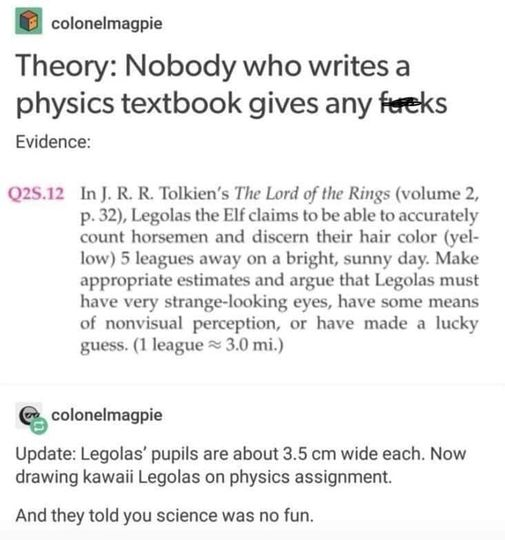this post was submitted on 09 Sep 2024
697 points (98.7% liked)
Science Memes
12295 readers
1256 users here now
Welcome to c/science_memes @ Mander.xyz!
A place for majestic STEMLORD peacocking, as well as memes about the realities of working in a lab.

Rules
- Don't throw mud. Behave like an intellectual and remember the human.
- Keep it rooted (on topic).
- No spam.
- Infographics welcome, get schooled.
This is a science community. We use the Dawkins definition of meme.
Research Committee
Other Mander Communities
Science and Research
Biology and Life Sciences
- !abiogenesis@mander.xyz
- !animal-behavior@mander.xyz
- !anthropology@mander.xyz
- !arachnology@mander.xyz
- !balconygardening@slrpnk.net
- !biodiversity@mander.xyz
- !biology@mander.xyz
- !biophysics@mander.xyz
- !botany@mander.xyz
- !ecology@mander.xyz
- !entomology@mander.xyz
- !fermentation@mander.xyz
- !herpetology@mander.xyz
- !houseplants@mander.xyz
- !medicine@mander.xyz
- !microscopy@mander.xyz
- !mycology@mander.xyz
- !nudibranchs@mander.xyz
- !nutrition@mander.xyz
- !palaeoecology@mander.xyz
- !palaeontology@mander.xyz
- !photosynthesis@mander.xyz
- !plantid@mander.xyz
- !plants@mander.xyz
- !reptiles and amphibians@mander.xyz
Physical Sciences
- !astronomy@mander.xyz
- !chemistry@mander.xyz
- !earthscience@mander.xyz
- !geography@mander.xyz
- !geospatial@mander.xyz
- !nuclear@mander.xyz
- !physics@mander.xyz
- !quantum-computing@mander.xyz
- !spectroscopy@mander.xyz
Humanities and Social Sciences
Practical and Applied Sciences
- !exercise-and sports-science@mander.xyz
- !gardening@mander.xyz
- !self sufficiency@mander.xyz
- !soilscience@slrpnk.net
- !terrariums@mander.xyz
- !timelapse@mander.xyz
Memes
Miscellaneous
founded 2 years ago
MODERATORS
you are viewing a single comment's thread
view the rest of the comments
view the rest of the comments

It depends on the atmosphere. On earth, the average 'size' of the atmospheric distortion experienced by a photon over 15 miles would far exceed the angular resolution of any pupil-sized aperture. This is a very simple explanation which groups a number of propagation effects broadly under the term "distortion." Even without atmospheric distortion, there is a limit to the "information" a given aperture can resolve due to purely thermal noise. In theory, if you have an aperture temperature of absolute zero, the thermal resolution is infinite, but also then there is no process by which information can be generated by an I cident photon.
No, even without an atmosphere you have to contend with the diffraction-limited resolving power through an aperture (pupil), which is related to the diameter of the aperture and the wavelength of light.
A diffraction process is, mathematically, a fourier transform. A fundamental mathematical feature of a fourier transform is what's known as the uncertainty principle.
Side note: you've probably heard of the special case of an uncertainty principle encountered in quantum mechanics frequently misattributed to the head of the Nazi nuclear program (Heisenberg), but this mathematical principle was actually well known for centuries beforehand, and the misattribution is mostly because of Nazi propaganda. We see it anywhere a fourier transform is used, from optics to orbital dynamics to quantum particles. This mathematical phenomenon is frequently miscited as quantum "weirdness" even though there's nothing quantum (or all that weird) about it.
The pupil restricts the possible positions of incoming photons. A restriction in position increases the variance of momenta (for a photon, speed never changes, but the momentum vector can still change direction). A smaller pupil is more restrictive and causes the image to be blurrier as the incoming photons from each object you are trying to resolve. If you want to be able to resolve smaller angular sizes (small objects at large distances), you need a large aperture that reduces position restrictions on incoming photons and therefore diffraction-induced blurring due to momentum uncertainties.
Look up Airy diffraction for the special case of a circular aperture (e.g. a pupil or telescope).